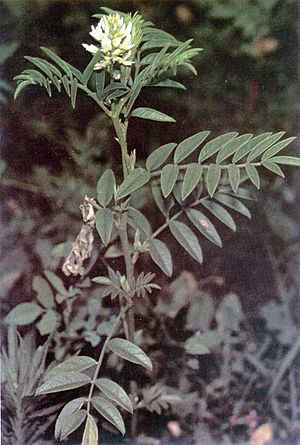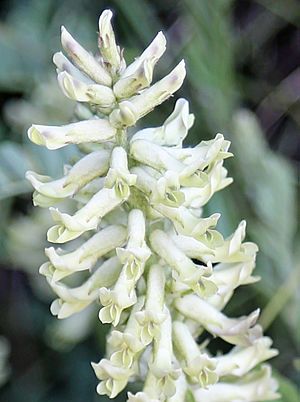American licorice facts for kids
Quick facts for kids American licorice |
|
|---|---|
 |
|
| Scientific classification | |
| Kingdom: | |
| (unranked): | |
| (unranked): | |
| (unranked): | |
| Order: | |
| Family: | |
| Genus: | |
| Species: |
G. lepidota
|
| Binomial name | |
| Glycyrrhiza lepidota (Nutt.) Pursh
|
|

American licorice (its scientific name is Glycyrrhiza lepidota) is a cool plant. It belongs to the same family as peas and beans, called Fabaceae. You can find it growing across most of North America. It stretches from central Canada all the way south through the United States. This includes states like California, Texas, and Virginia. However, it doesn't grow in the southeastern parts of the U.S.
People sometimes call it "wild licorice." This helps tell it apart from the European licorice plant. That one is often grown for the sweet candy we know.
Contents
What is American Licorice?
American licorice is a plant that loves wet ground. It can grow in tough, heavy soil, but it really prefers sandy places. This plant can grow to be about 40 to 100 centimeters (16 to 39 inches) tall. It has long, strong brown roots.
Sweet Roots and Ancient Uses
These roots are known for being sweet. Long ago, Native Americans used them for food and for natural remedies. In 1806, an explorer named Meriwether Lewis tried a roasted root. He said it had a nice taste, a bit like a sweet potato!
The sweetness in American licorice doesn't come from sugar. Instead, it comes from a special substance called glycyrrhizin. The Zuni people used to chew the root. It helped keep their mouths sweet and moist.
Where Does it Grow?
American licorice is a tough plant. It can be one of the first plants to grow in bare or disturbed ground. This means it often pops up in places where the soil has been moved or changed. It's also often the first plant to appear when a salty, dry area, called an alkali flat, starts to get wetter.
Plant Life Cycle
This plant has light green to white flowers in the spring. As fall arrives, these flowers turn into clusters of burs. These burs hold small, bean-like seeds inside pods.
Cattle sometimes eat American licorice. However, it's not their favorite food. If other plants are eaten by grazing animals, American licorice can actually grow more. This is because it faces less competition.
See also
 In Spanish: Glycyrrhiza lepidota para niños
In Spanish: Glycyrrhiza lepidota para niños
Images for kids
-
The burrs (seeds) of wild licorice growing near the South Saskatchewan River.


